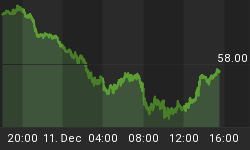Every precious metals investor should be concerned about China raising its rates and rising yields. Rising rates in one of the fastest growing economies will affect precious metals investors. Changes in the rates affect stock prices. China is leading the world and we can see the fears are profound as sell offs this week were much stronger that any of the relief rallies. If China's market corrects then the commodity market which was fueling the equity market could experience a severe correction. It is a domino effect.
Despite The Fed's enthusiastic plan to monetize debt and artificially keep interest rates low through bond purchases, yields have risen aggressively for the last thirteen weeks. The QE2 program was designed to lower interest rates to improve borrowing and liquidity. Instead the opposite occurred, QE2 is initiating higher borrowing costs. I don't believe it is coincidence that Ireland's debt problems surfaced following QE2. China is now on the verge of raising rates to combat imported cheap dollars to bid up Chinese assets, which is putting pressure on markets globally. Rising rates kills equity and commodity markets which is heavily built on margin borrowing.
The Long Term Treasury Etf broke through the trend it had from May until the end of August. This previous trend was largely a result of a deflationary crisis where investors ran from risky assets like the Euro to the Dollar and Long Term Treasuries (TLT) were pushing yields to ridiculously low levels. As fear in the markets decreased, due to a temporary stabilization in Europe and the U.S., investors ran to equities and commodities.
International reaction to QE2 has not been positive. There is an increased risk of emerging markets combatting inflation which may slowdown the global recovery. Fears of China and emerging markets raising rates make investors unsure where to turn.
Asset classes have reacted negatively to China's expected move. Distribution is apparent through many sectors and many international markets. Rising interest rates have a direct influence on corporate profits and prices of commodities and equities.
When studying interest rates it is not the level that is important it is the rate of change. Interest rates have had a dramatic increase these past two months and we may see that effecting the fundamentals in the economy shortly.
The recent downgrade on U.S. debt from China, who is our largest creditor signals demand for U.S. debt has been waning. I've been highlighting the decline in long term treasuries (TLT) since the end of August. This rise in interest rates puts further pressure on the recovery as the cost of borrowing increases. Economic conditions are worsening in Europe and emerging markets, in reaction to quantitative easing and imported inflation. Concerns of sovereign debt issues are weighing in Europe. As yields rise so do defaults and margin calls.

If the 200 day is unable to hold the bond decline and we continue to collapse then rising interest rates could negatively affect the economic recovery. Borrowing costs to insure government debt are reaching record levels internationally. Ireland is expected to take a bailout. Greece, Spain and Portugal are in danger as well.
Commodities have significantly moved higher along with the equity market for September and October as investors left treasuries to return to risky assets due to the fear of debt monetization through QE 2. Global equity markets have been rising. But the question is how long? This makes investors reluctant to take on debt which is the exact opposite than what the Fed's goals were. Rising yields could lead to a liquidity trap and deflationary pressures.
Grab your free 30-day trial of my Members-Only Premium Stock Analysis Service NOW at http://goldstocktrades.com/premium-service-trial
Disclosure: No Stocks Owned That Have Been Mentioned In This Article.
















